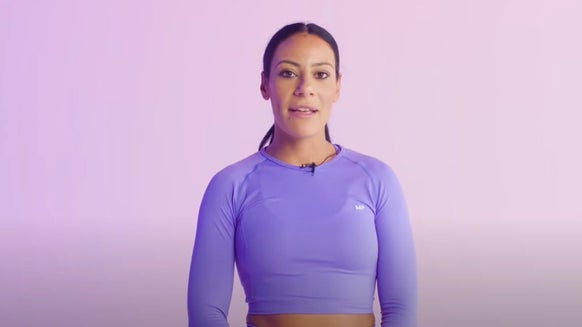
Unsure on how to start running? It can be hard to know what kind of distance or pace you’ll be able to manage when you first set off, and can take a while to get a feel for what’s most comfortable for you. As well as this, just like with any exercise that you’re trying for the first time, you need to start off light and slow to build up strength and avoid injury.
With the help of registered dietitian and personal trainer, Chrissy Carroll, we’ve put together a plan to help you to tie up your trainers and get pounding the pavements in no time at all. We’ve made running for beginners nice and straightforward, along with some handy running tips to get you motivated.
Chrissy’s a keen runner herself, having taken part in triathlons and marathons, as well as being a triathlon coach. Her blog has plenty of handy tips and tricks on nutrition, as well as running, whether you’re a seasoned runner or triathlete, or just starting out.
Still not sure that running’s worth breaking a sweat for? We’ve looked into the health benefits to get you started…
Benefits of Running
A study in the Journal of Adolescent Health proved that just 30 minutes of running during the week for 3 weeks could improve sleep quality, mood and concentration during the day.1
When compared with cyclists, runners have a higher bone mineral density which reduces your risk of broken bones.2
Despite what you may have been told, studies show that there are no links between running and arthritis in the knees. A 2008 study — after a 21-year follow-up period — even found that runners experienced significantly less musculoskeletal disability than nonrunners in the study.3
Put all of these benefits with the fact that you’ll be outdoors more, have healthier heart and lungs, tone up and be able to consume more calories, and there really is no reason not to at least give running a try!
Your Running Plan
The first step, beyond buying some well-fitting trainers, suitable for whatever type of running you choose — trail, road or track — is getting a plan together.
From her training experience and many hours of running, Chrissy’s put together a 4-week running plan for beginners. She says, “This plan will get you started, bringing you from not running at all to being able to jog 15 minutes comfortably. Once you can do that, keep running a few days a week — and each week, add on about 5-10 minutes to your runs. Most people can run their first 5K in around 30-45 minutes, so when you can run that far comfortably — you're ready!"
Monday — 10-minute walk, 2 minutes running/2 minutes walking (repeat x4), 5-minute walk
Wednesday — 10-minute walk, 4 minutes running/2 minutes walking (repeat x3), 5-minute walk
Thursday — 30-minute fast walk
Saturday —10-minute walk, 3 minutes running/1 minute walking (repeat x4), 5 minute walk
Monday — 10-minute walk, 4 minutes running/1 minute walking (repeat x4), 5-minute walk
Wednesday — 10-minute walk, 6 minutes running/3 minutes walking (repeat x2), 5-minute walk
Thursday — 35-minute fast walk
Saturday — 10-minute walk, 5 minutes running/2 minutes walking (repeat x3), 5-minute walk
Monday — 10-minute walk, 6 minutes running/2 minutes walking (repeat x3), 5-minute walk
Wednesday — 10-minute walk, 7 minutes running/3 minutes walking (repeat x2), 5-minute walk
Thursday — 40-minute fast walk
Saturday — 10-minute walk, 8 minutes running/5 minutes walking (repeat x2), 5-minute walk
Monday — 10-minute walk, 10-minute run, 5-minute walk
Wednesday — 10-minute walk, 8 minutes running/4 minutes walking (repeat x 2), 5-minute walk
Thursday — 40-minute fast walk
Saturday — 10-minute walk, 15-minute run, 5-minute walk
Tips and Motivation
Once you get into the swing of following a plan, you’ll be encouraged even more as you start to see progress. However, even the pros need a little extra motivation and tips to help them along the way:
1. Nutrition
When you start running, it’s a good idea to take a look at your diet to firstly make sure you’re eating enough calories, and secondly to start eating the right foods.
Chrissy says, “If you're curious about how many calories to eat each day, try using an online food tracker or app. You'll be able to enter factors like your height, weight, gender, and training schedule — and get an estimate of your daily calorie needs. Keep in mind some apps and websites underestimate calories, so the best way to assess if you're meeting your needs is if you're maintaining a healthy weight.” If you're unsure if you are at a healthy weight, use our BMI Calculator to see what category you are in.
Food such as sweet potatoes, plant-based meat substitutes, or lean meat alternatives, wholegrain pasta and cereals, plenty of fruit and vegetables and omega-3 rich fish such as salmon, are all good options. You’ll also want to ensure you’re getting enough protein for muscle repair and growth.
2. Motivate Yourself
Grab a running buddy, join a club or simply race the person next to you on the treadmill. Having someone to exchange notes with is an invaluable way to ensure you stay focused on your goals.
If you prefer running solo, however, there are still plenty of ways to keep on track. Buy a physical calendar and mark the days off old-school fashion down to race day. Hang it somewhere you won’t miss it, like your kitchen, to ensure that it’s always front-of-mind.
Another good, if slightly cheesy, visual cue is to start a Pinterest board full of inspirational running and fitness quotes, along with pictures of your favourite runners to keep you motivated.
If all else fails, bribe yourself with a treat — new running trainers are a good one — for when you have completed a goal.
3. Rehabilitation
The importance of warming up before and stretching after you have been out, whether you walk, jog or run, is paramount.
Listening to your body if you feel any soreness, tightness or if something generally isn’t ‘right’ is always a good idea too. Don’t assume it will vanish and certainly don’t keep running on an ankle or knee that’s hurting.
Going for a proper sports massage as a treat is a great way of keeping your muscles supple and injury at bay. When you build up to running three times per week or more, think about cross training, or another form of exercise, to use different muscles and give your overworked ones a break.
Take Home Message
Running for beginners doesn’t have to be rocket science — listen to your body and enjoy it. Running is a sport you can get into without much costly training or specialist equipment and the rules are basic: set a goal, have a plan and motivate yourself with whatever works. Ensure you’re getting the proper nutrition, stretch and recover and most of all, have fun!
You don’t have to be competitive to enjoy running. Even a gentle, solo jog on a warm summer’s day is just as enjoyable as getting your personal best time for running a 10k.

1 Kalak, N., Gerber, M., Kirov, R., Mikoteit, T., Yordanova, J., Pühse, U., … & Brand, S. (2012). Daily morning running for 3 weeks improved sleep and psychological functioning in healthy adolescents compared with controls. Journal of Adolescent Health, 51(6), 615-622.
2 Sohn, R. S., & Micheli, L. J. (1985). The effect of running on the pathogenesis of osteoarthritis of the hips and knees. Clinical Orthopaedics and Related Research, (198), 106-109.
3 Chakravarty, E. F., Hubert, H. B., Lingala, V. B., Zatarain, E., & Fries, J. F. (2008). Long distance running and knee osteoarthritis: a prospective study. American journal of preventive medicine, 35(2), 133-138.







